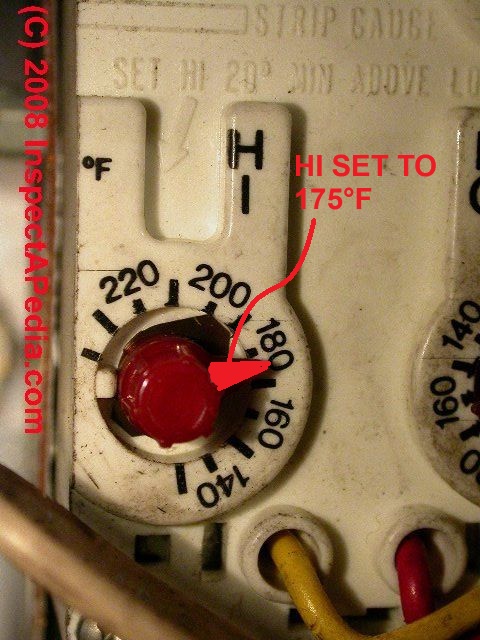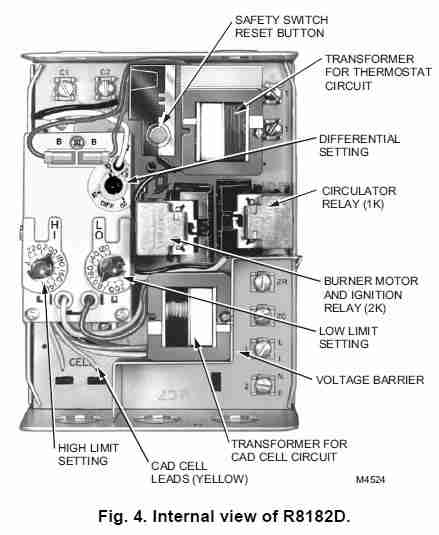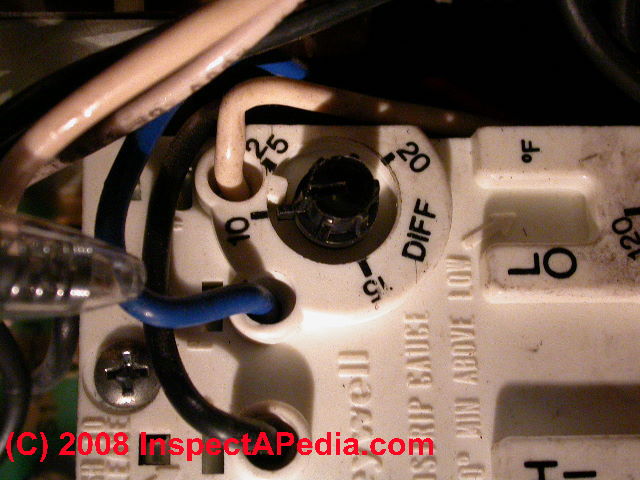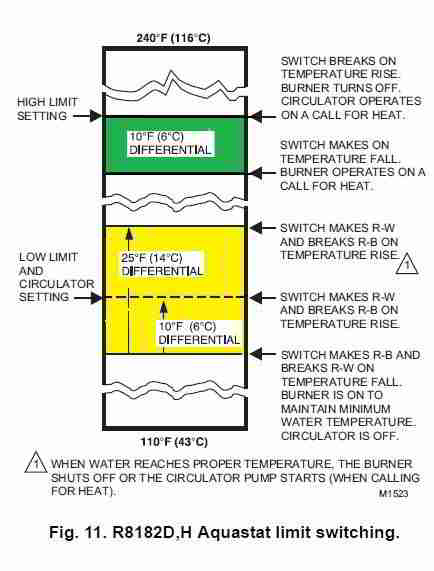 Best High, Low, & DIFF Settings on a Heating Boiler Aquastat?
Best High, Low, & DIFF Settings on a Heating Boiler Aquastat?
- POST a QUESTION or COMMENT about the best settings for aquastat controls on heating boilers
Best settings for a heating boiler aquastat control:
Here we explain how to choose the best settings for a heating boiler aquastat - the combination control that sets boiler temperature and may also control hot water production via a tankless coil on the heating boiler.
The photo above shows a the "HIGH" or "HI" setting on a Honeywell R8124A combination heating control, also called an "aquastat". This control was set to 175°F - in our opinion not high enough.
This article series answers most questions about Heating System Boiler Controls on central heating systems to aid in troubleshooting, inspection, diagnosis, and repairs.
InspectAPedia tolerates no conflicts of interest. We have no relationship with advertisers, products, or services discussed at this website.
- Daniel Friedman, Publisher/Editor/Author - See WHO ARE WE?
What Settings To Use on a Heating Boiler Aquastat Combination Control
Lots of people, even some service technicians are confused about the actual function of combination controls and aquastats like the Honeywell R8182D. Some don't know how to set the "HI", "LO" and "DIFF" dials on a combination control.
Here we'll explain how to make the best settings of HI, LO and DIFF on a typical heating boiler aquastrat controller.
The internal view of the Honeywell R8182D shown here can be found along with additional details about this control in the Honeywell R8182D,H Combination Protectorelay™ Primary Control and Aquastat® Controller Installation Instructions (link to copy below atReferences or Citations ).
Article Contents
- AQUASTAT SETTING RULE OF THUMB
- BEST HI LIMIT SETTING
- BEST LO LIMIT SETTING
- CIRCULATOR LOCKOUT EXPLAINED - "crossed controls" - what happens if HI is set below or too close to LO?
- BEST DIFF SETTING - to get the most hot water
- DISABLE the LO & DIFF CONTROLS on an AQUASTAT - if the tankless coil is absent or not in use
This widely-used Honeywell (Resideo) R8182D,H aquastat can replace other aquastat controls such as the Tradeline R8182B, R8182E, R8182F, R8182H, R8182J, or White Rogers 6C92.
A newer universal combination aquastat control is also from Honeywell (now Residio),
the HONEYWELL L7224U OIL ELECTRONIC AQUASTAT CONTROLLER can replace more than 40 older hydronic controls.
At AQUASTAT CONTROLS we explain how aquastats work, defining the functions and dials of the aquastat HI LO and DIFF control along with the reset button often found on these heating boiler controls.
...
Rule of Thumb for Setting HI LO DIFF on an Aquastat
Or more commonly, we were taught to just use a "rule of thumb" which set the
- HI to 180 °F (should be 200F or lower)
- a HI-DIFF value is hard-wired in the R8182 series type aquastats, is not adjustable, and no control dial is provided.
A programmable HI-DIFF is available on on some programmable aquastats such as
the AQUASTAT L7224U UNIVERSAL and can be adjusted.
- a HI-DIFF value is hard-wired in the R8182 series type aquastats, is not adjustable, and no control dial is provided.
- LO to 160 °F (must be 20 below HI)
- DIFF (or LO-DIFF) on most aquastats such works with the LO limit only and is often set to 10, or is just set randomly (not recommended - proper numbers are below) .
These were "Safe" settings for this control, and it's in with similar settings on millions of heating boilers. But with a little thought, we can adjust these HI LO DIFF settings and thus set the heating aquastat control so as to save a bit more on heating cost, and/or we can set the control to give us a bit more hot water where a tankless coil is installed.
...
Guide to Best Settings for the HI Limit on a Honeywell R8182D Heating Boiler Aquastat & Similar Controls:

The "HI" on a combination heating control like this aquastat is usually set by the heating service technician to a spot between 180 °F and 200 °F.
Our photo above shows that someone has set this aquastat HIGH LIMIT to 175°F - in oujr opinion this is too low and it will increase heating cost and reduce heating system performance.
In a the "rule of thumb" many heating service technicians just park the HI at about "180" °F.
Setting the HI: save money on heating costs by running the boiler at a higher temperature
Generally a heating boiler is more efficient if we operate it at a higher temperature.
The thermal conductivity of heating water inside of finned copper tubing baseboards or through radiator surfaces is exponentially greater at higher temperatures.
In other words, hotter water actually transfers heat into the occupied space more efficiently than cooler water.
Since this is not lab-grade equipment these settings are not precisely accurate. For this reason we like to set our HI limit at around 200 °F.
We let the boiler run through a few heating cycles, watching the temperature and pressure gauges on the boiler to see what temperature we're actually reaching. And we watch the boiler relief valve to be sure we're not causing leakage there.
Watch out: Setting the "HI" too high on the aquastat can result in over-temperature in the heating boiler and can result in dumping water and temperature and pressure at the relief valve.
If your TP valve was not leaking before and it begins to drip when you set up the HI to 200 F, step the HI back to 195 and try that setting.
If your TP valve is leaking at 195 or less it's likely that you need a heating service call - something's probably wrong with the relief valve, with system operating pressures, or with the controls.
...
Guide to Best Settings for the "LO" Limit on a Honeywell R8182D Heating Boiler Aquastat & Similar Controls

In our drawing above and in the detailed photo below you'll see where the heating service tech left this "LO" limit control after cleaning and tuning the heating boiler.
This LO limit dial was set to about 167 degF.
The "LO" limit must always be set to at least 20°F. below the "HI" limit on a combination aquastat control.
Watch out: if the LO is set to 163 degF on this boiler's aquastat then if the boiler HI was set to any temperature less than 183 degF (20 degF above the LO) the circulator will be locked out - it won't run.
More generally, if we set the "LO" too close to the "HI" limit, the control, trying to give priority to making domestic hot water for someone in the shower, will simply lock out the circulator pump entirely - this boiler's circulator pump won't ever run and the delivery of heat will be at a snail's pace, leaving grouchy building occupants and a higher cost.
Your heat will work, but slowly, and more expensively, as we explain next
We like to keep our LO set at 20 F below the HI. That keeps the LO temperature operating range as high as possible in the boiler and that in turn gives us the most heat stored in the boiler for making hot water through the tankless coil.
...
Avoid Circulator Lockout: Always Set LO 20°F or more below HI
What happens if you "cross the controls" and set "LO" above "HI" or if you set "LO" too close to "HI"? The circulator will not run.
Watch out: don't set the LO above or higher than the HI temperature limit. If you make that mistake, you will lock out the circulator pump and your heating system will not work properly. We call this "lock out" - the circulator will be locked out of running on a call for heat. Others call this LO higher than HI "crossed controls".
We've inspected homes at which the owner, for decades, observed that the heat in the building was very slow to come up in response to the thermostat. The problem was that the LO was set close to or even above the HI - the circulator pump never ran and hot heating water circulated but only very slowly by convection.
We found a home where the owner had set the "HI" to 120 and the "LO" to 180. Luckily for them, because their flow-control valve was either absent or not working, their home would indeed receive heat - but very slowly: their circulator pump had never run.
On seeing this setting we asked the owner about it. "Well you know", he said, "we have noticed that the house was always very slow to heat up in winter."
Thanks to reader L. Clark for pointing out that we had inconsistent language in this explanation. It's been fixed, and fixed again thanks to reader Damian for suggesting further clarifications.
...
Guide to Setting the "DIFF" (differential) on a Honeywell R8182D heating boiler aquastat & Similar Controls:

Where a tankless coil is installed on a heating boiler to make domestic hot water (for washing and bathing) we prefer to set the differential (DIFF) to its highest number (usually 25 degrees) so that people using hot water in the building will have as much hot water supply as possible.
Our photos above and below show the DIFF adjustment on a Honeywell aquastat.
This DIFF is set to its lowest value: 10 °F.
At the setting shown, if LO were set to 120, when the burner is re-heating the boiler water and water temperature rises to 130 F the burner will turn off and the heating circulator pumps will be allowed to turn on (and they will actually turn on if the room thermostat is calling for heat).
If you re-set the DIFF dial up to its maximum of 25 and LO remained at 120 F, then when the burner is re-heating the boiler water and water temperature rises to 145 F the burner will turn off and the heating circulator pumps will be allowed to turn on (and they will actually turn on if the room thermostat is calling for heat).
In short, DIFF = 25 should give you hotter boiler temperature and thus more domestic hot water than DIFF = 10.
Still not enough hot water from your tankless coil?
First see HOT WATER IMPROVEMENTS where we discuss working with a tankless coil to get as much hot water as we can.
Then when your bath tub still doesn't have but a few inches of hot water,
see HOT WATER QUANTITY IMPROVEMENT
Watch out: be sure that a mixing valve or anti-scalding valve is installed to avoid hot water burns as well as to make effective use of this higher boiler temperature.
See ANTI SCALD VALVES & TEMPERATURE CONTROL / MIXING VALVES
For details about the HI, LO, and DIFF actually work, AQUASTAT CONTROL FUNCTIONS refer to our text and to the yellow-colored area in our colored version of the HI LO functions explained in detail
in that article's section that gives more details
about HOW THE HI AND LO LIMIT CONTROLS FUNCTION ON AN AQUASTAT above.
From that article, this quote helps explain what the DIFF control is doing on an aquastat:
When boiler temperature is rising:
on an aquastat control, the "DIFF" or differential control dial specifies the amount above the LO or "Low Limit" to which boiler temperature must rise before the burner will turn off and the circulator will be allowed to run.
It's not hard to understand why heating service techs and homeowners are confused about LO and DIFF settings on a heating boiler, but Honeywell got it right: if we are making hot water with a tankless coil, by locking out the circulator at lower boiler temperatures, the LO and DIFF make sure that heating priority is given to the woman in the shower, not to the building radiators.
[Click to enlarge any image]
The diagram above is explained
...
Disable the LO and DIFF settings on a Boiler Aquastat that Does Not Use a Tankless Coil for Domestic Hot Water

The DIFF feature on a boiler aquastat is there to provide control over boiler temperature when a tankless coil is in use to provide domestic hot water (for washing and bathing).
Out of the box a typical aquastat model that contains a DIFF circuit will come wired up or "active".
If your heating system does NOT include a tankless coil, or if a tankless coil is installed but is not connected to the building hot water piping, then the LO and DIFF are keeping heat in the boiler for a tankless coil that is not present and you could consider either disabling this circuit entirely or setting both LO and DIFF to their lowest settings.
And that's not always desirable. It depends.
In this case, the "LO" has almost no use whatsoever and, if you read the instructions provided by the control manufacturer you'll probably see that the manufacturer calls for the "LO" to be electrically disconnected entirely.
Details about how to make this change to a typical aquastat when you're not using a tankless coil on your boiler, along with problems to watch-out for have been moved to
where you'll see it's essentially a step to dis-connect a wire in the aquastat.
Keep in mind that the LO and DIFF control settings only make sense if the heating boiler has a tankless coil installed to make domestic hot water (for washing and bathing).
...
...
Continue reading at AQUASTAT LO & DIFF DISABLED or select a topic from the closely-related articles below, or see the complete ARTICLE INDEX.
Or see AQUASTAT HI LO DIFF SETTINGS FAQs - questions & answers posted originally at the end of this page.
Or see these
Recommended Articles
- AQUASTAT CONTROLS - home
- AQUASTAT HI LO DIFF SETTINGS
- AQUASTAT LO & DIFF DISABLED
- AQUASTAT L4006, L4006E, L4007 HONEYWELL GUIDE
- AQUASTAT L4080B,D & L8080A HONEYWELL MANUAL
- AQUASTAT L4080B,D,F,G & L8080A HONEYWELL MANUAL
- AQUASTAT L6006A HONEYWELL GUIDE
- AQUASTAT L7224U UNIVERSAL OPERATION & ERROR CODES
- AQUASTAT L7224U UNIVERSAL DIAGNOSIS
- AQUASTAT L8124 AQUASTAT INSTALL / REPAIR
- AQUASTAT L8148 AQUASTAT INSTALLATION
- AQUASTAT L8148 HONEYWELL DIAGNOSIS & REPAIR
- AQUASTAT R8182-SERIES CONTROL
- AQUASTAT RESET BUTTON
- AQUASTAT SENSOR PROBE HEAT CONDUCTING COMPOUND
- AQUASTAT SENSOR PROBE STUCK in the AQUASTAT WELL
- AQUASTAT SETTINGS vs HEATING COST
- AQUASTAT SELECTION GUIDE
- OUTDOOR RESET MODULE AQUASTAT ADJUSTER
- REMOTE THERMOSTAT CONTROLS for HVAC
- TANKLESS COIL HOT WATER HEATER TEMPERATURE CONTROL
- HOT WATER IMPROVEMENTS using a tankless coil and additional controls to get as much hot water as we can.
- MANUALS for HEATING & A/C SYSTEM CONTROLS
- SINGLE FUNCTION LIMIT SWITCH
Suggested citation for this web page
AQUASTAT HI LO DIFF SETTINGS at InspectApedia.com - online encyclopedia of building & environmental inspection, testing, diagnosis, repair, & problem prevention advice.
Or see this
INDEX to RELATED ARTICLES: ARTICLE INDEX to HEATING BOILERS
Or use the SEARCH BOX found below to Ask a Question or Search InspectApedia
Ask a Question or Search InspectApedia
Questions & answers or comments about the best settings for aquastat controls on heating boilers
Try the search box just below, or if you prefer, post a question or comment in the Comments box below and we will respond promptly.
Search the InspectApedia website
Note: appearance of your Comment below may be delayed: if your comment contains an image, photograph, web link, or text that looks to the software as if it might be a web link, your posting will appear after it has been approved by a moderator. Apologies for the delay.
Only one image can be added per comment but you can post as many comments, and therefore images, as you like.
You will not receive a notification when a response to your question has been posted.
Please bookmark this page to make it easy for you to check back for our response.
IF above you see "Comment Form is loading comments..." then COMMENT BOX - countable.ca / bawkbox.com IS NOT WORKING.
In any case you are welcome to send an email directly to us at InspectApedia.com at editor@inspectApedia.com
We'll reply to you directly. Please help us help you by noting, in your email, the URL of the InspectApedia page where you wanted to comment.
Citations & References
In addition to any citations in the article above, a full list is available on request.
- Thanks to Bottini Fuel service manager Ron Thomas for discussing aquastat functions, low limit controls, oil burner short cycling causes, and boiler maintenance, reliability, and service contracts 4/13/2010. Bottini Fuel is a residential and commercial heating oil distributor and oil heat service company in Wappingers Falls, NY and with offices in other New York locations. Bottini Fuel, 2785 W Main St, Wappingers Falls NY, 12590-1576 (845) 297-5580 more contact information for Bottini Fuel
- Thanks to reader L. Clark for pointing out that we had made an error in our HI and LO setting language - October 2010
- Thanks to reader Damian for clarifying the LO and DIFF setting functions - March 2011
- We provide links just below to several aquastat installation, setting, and adjustment documents in response to reader requests and comments that people sometimes have difficulty finding this information. But readers looking for specific aquastat control information should always first try the control manufacturer.
- Armstrong 24-hour time and aquastat control accessory: provides on/off pump control according to preset operating times, designed only for use with specified Armstrong Astro series wet roto circulators installed in indoor hot water re circulation applications. Typical timer applications will cycle the pump at preset times, allowing the user to select operation of the circulating pump during high peak usage periods in order to decrease the delivery time to outlet fixtures and reduce wasted water, also available at www.honeywell.com
- Honeywell Corporation, control installation guides for Honeywell aquastats and other heating and cooling controls: see http://customer.honeywell.com
- Honeywell L4008E Aquastat high limit,manual reset, aquastat controller instructions
- Honeywell L4041A,C Pool Heater Aquastat Controller Instructions, also available at www.honeywell.com
- Honeywell L4006, Manual Reset Strap-On Aquastat (high limit control, 100 to 240 °F) [we consider strap on controls less accurate and reliable than immersion type sensor controls; these were commonly found on older heating boilers including the GE series downfired boilers]
- Honeywell L4026B Aquastat control instructions (contact Honeywell Corporation) Here is some basic description of the Honeywell L4026B control, also available at www.honeywell.com
- Honeywell L4029 Reset Limit Control, also available at www.honeywell.com
- Honeywell L4103A,B,C Combination Aquastat and High Limit Controller Instructions, also available at www.honeywell.com
- Honeywell L6006A Aquastat Controller installation instructions, also available at www.honeywell.com
- Honeywell L6006 and L6007 Aquastat Controllers, installation instructions for the trained service technician, these controls combine low or high limit and circulator control, with or without an immersion well depending on the control model A,B, C etc., also available at www.honeywell.com
- Honeywell L6191 Dual aquastat immersion thermostat, also available at www.honeywell.com
- Honeywell R7184 Interrupted Electronic Oil Primary R7184A,B,P,U Installation Instructions, also available at www.honeywell.com
- Honeywell R7184 Series Primary Controls Technicians Quick Reference Guide, also available at www.honeywell.com
- Honeywell L7224 Aquastat Controller, oil electronic controls allowing high limit, high limit differential, low limit, and separate low limit differential settings - set to the specifications of your oil heating equipment manufacturer - 69-1957-1 L7224 Series controls, also available at www.honeywell.com
- Honeywell L7224U Oil Electronic Aquastat Controller - 69-1720-2 series instructions. These newer aquastat controllers are often used to replace the older Honeywell L8124A series that was and remains widely used, also available at www.honeywell.com.
- Honeywell L8124A,B,C,E,G,LO,M Aquastat Relays immersion type controllers for forced hydronic heating systems that include domestic hot water service (such as a tankless coil), also available at www.honeywell.com
- In addition to citations & references found in this article, see the research citations given at the end of the related articles found at our suggested
CONTINUE READING or RECOMMENDED ARTICLES.
- Carson, Dunlop & Associates Ltd., 120 Carlton Street Suite 407, Toronto ON M5A 4K2. Tel: (416) 964-9415 1-800-268-7070 Email: info@carsondunlop.com. Alan Carson is a past president of ASHI, the American Society of Home Inspectors.
Thanks to Alan Carson and Bob Dunlop, for permission for InspectAPedia to use text excerpts from The HOME REFERENCE BOOK - the Encyclopedia of Homes and to use illustrations from The ILLUSTRATED HOME .
Carson Dunlop Associates provides extensive home inspection education and report writing material. In gratitude we provide links to tsome Carson Dunlop Associates products and services.





